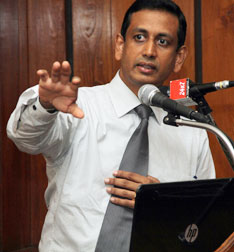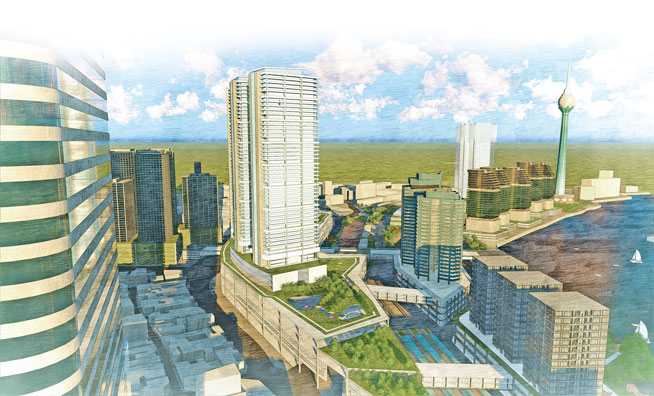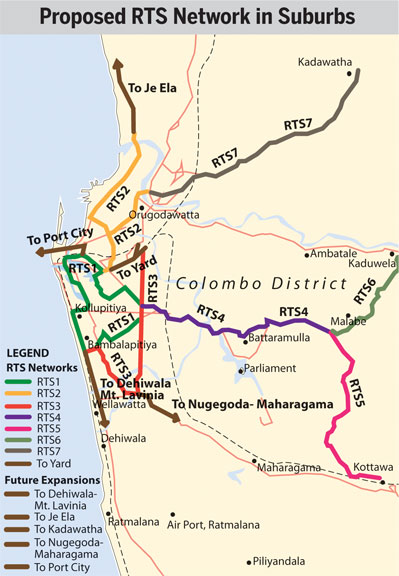Bids for f irst projects within six months
Megapolis: Unraveling dramatic transformation of the
city:
By Chandani Jayatilleke
A host of investment opportunities from industrial estates and
townships, and light rail, water and bus transport services will be
available for private sector investors under the proposed Megapolis
Project.
|

The idea is to integrate all transport services into one
point - Nayana Mawilmada
PICTURE BY RUWAN DE SILVA |
In an interview with the Business Observer, Head of Investments of
the Western Region Megapolis Planning Project, Nayana Mawilmada outlines
the current state of play of the project which aims to bring about a
radical transformation of the city and its surroundings.
Question: The Megapolis expert team has been working on the master
plan for over a year now and investors are eager to find out about the
actual investment opportunities available. How do you intend mobilizing
investments, what is the government's share and what will be offered to
the private sector?
Answer: It is difficult to give an exact number on this figure right
now because we are at the early stage. But we are leaning very heavily
towards private sector - we expect the vast majority of this to be
private sector-driven. That said, some of the initial projects will be
with state financing; that is to anchor the investments. Going forward,
it would be private sector investments.
Q: What sort of projects are available for private sector investors?
A: For example, in the Megapolis plan we have various industrial
estates and townships, like Horana and Mirigama where we are on the
lookout for out for the right investors. We are consolidating lands
before calling for bids. We expect multiple players to play, because
these are very large ambitious investments.
We also expect the private sector to invest in some of the large
infrastructure projects such as the proposed highway connecting Kelani
Bridge to Battaramulla, water transport around Beira Lake and the Light
Rail Transit (LRT) project. We expect local or foreign investors or
collaborations between such entities, with previous experience
preferably.
For example, right now we are consolidating Beira Lake real estate
into one entity. Then we can start to put it out in a rational way. All
these will be open to local and foreign investors.
Q: When do you plan to offer the first projects for investments?
A: Within the next six months a few projects will be announced. We
were in the planning phase of the project for several months and were
trying to get critical backbone pieces in.
These processes take time. Now the government is trying to clarify
the status of the proposed Megapolis Authority and we expect the draft
act to be debated and the authority's establishment to happen over the
next few months. These processes take time; there are various
stakeholders and institutions to synchronize under the authority.
We are talking about projects of billions of dollars and they have to
be palatable to a majority. It is worth spending time to get it right
now through a democratic process rather than making quick and wrong
decisions.
Q; How do intend promoting the envisaged investments?
|

An artistís impression of what the banks of the Beira would
look like. |
A: We will put them out for transparent tenders. We need to promote
it in the countries which have shown a lot of interest already,
including Singapore, Japan, China, France, Germany and India. Over the
last few months, we had a lot of visiting business delegations.
We hope to do roadshows and international promotions. Besides I would
be very keen to explore the Indian interests in the manufacturing space
for example, and plugging into India's value chains would be very
beneficial.
For India it would be easier to serve southern India from Sri Lanka
than from northern India. The proposed India-Sri Lanka Economic and
Technology Cooperation Agreement (ETCA) will open up some doors.
Q: What is the legal and regulatory framework for the project?
A: At present we work very much in tandem with the Urban Development
Authority (UDA) which is executing a lot of work which we cannot do,
like land acquisition.
The UDA will be a separate institution which will work under the
overall guidance of the Megopolis Authority. The Megapolis Authority
should have the ability to coordinate and synchronize all the various
other agencies' operations, such as UDA.
For instance, roads will be done by the Road Development Authority.
Housing is a bit of a debate, because UDA is doing a bit, and National
Housing Development Authority is doing some.
What will change are land powers which we expect will get
consolidated at the Megapolis Authority level. One of the issues we have
is that land is disaggregated among so many institutions and it is very
difficult to assemble it and mobilize it. That we really want to fix and
the Megapolis Act should provide us that provision to pull it all under
one window where, at a macro level, we can make policy decisions on how
we work on to utilize land.
That will simplify matters for investors - give a single window when
they want to find assets in the Western Province. It is an important
provision and will settle one of the key hindrances we have. You don't
know what plans the other institution is having in connection with a
development project as of now.
Q: Why did you decide to prioritize the LRT before the bus
modernization project?
A: This is to be financed by Japan International Co-operation Agency
(JICA) with a concessional loan. They will do the build out and we're to
operate the entire project - managing stations, services and terminal
facilities.
Now the LRT project has come to the 'feasibility study' level. My
view is they both should happen. The reason we pushed the light rail
initially was because it needs a long lead time. We needed to get it
started first and we will start looking at the bus network now.
The bus network is essential as it is the feeder network for both
electric and light rail systems. While the LRT project is on over the
next few years, we will focus on the bus modernization project. We have
already had some initial discussions in this regard. We need to do
detailed work on this at present. That is of high priority.
Q: How do you propose to go ahead with the bus modernization project?
A: We need to rethink the routing network, considering the buses are
a feeding network for light and electric rail transport.
We need better buses with all kinds of facilities such as better
quality interiors, comfort, GPS technology and electronic ticketing
services.
And thirdly, to set up an organizational structure to run bus
services. At present we have several thousands of bus operators while
most countries have a handful. We need to give better service first and
then implement traffic congestion charges and bring in other rules and
regulations.
Q: What is the present stage of activity with regard to the proposed
transport hub in Pettah?
 A:
We are now working on consolidating the lands from Fort railway
station to the Technical College junction. We are also strategizing how
we can move ahead with the multi modal hub and how we can get it as fast
as possible. We are also cleaning up the Beira Lake in a sustainable
way. A:
We are now working on consolidating the lands from Fort railway
station to the Technical College junction. We are also strategizing how
we can move ahead with the multi modal hub and how we can get it as fast
as possible. We are also cleaning up the Beira Lake in a sustainable
way.
By end of the year we'll have a clear picture to go ahead with the
project. Fort is the most connected town in Sri Lanka, with a half a
million persons going through Pettah each day.
There are also 200 acres of land right around the Beira Lake - from
along D R Wijewardena Mawatha to Lake House - mostly owned by the
government.
Once the framework is in place we are sure the private sector will
capitalize on that. Private lands will not be acquired unless it is
absolutely necessary - by and large we expect the private sector to
develop those lands on their own.
Q: Can you explain how the transport hub will work?
A: The first thing we will do is we will consolidate all the
transport activities which are scattered around Pettah/Fort into one
consolidated facility. The buses scattered all over Pettah will be
consolidated into one integrated building - that will be combined with
the railway station building - so it will be a seamless transfer from
rail to bus. The light railway will also come straight through that.
There will also be a water transport facility within the Beira Lake.
That building will also get integrated into the same location.
The idea is to integrate everything for a very efficient customer
experience - and at the same time that will release a lot of real estate
that is currently used for a very inefficient bus service, from
Bodhiraja Mawatha to Manning market.
The Manning market will be relocated. The UDA is doing that now. We
are doing urban designing work, how to clean up the lake - the UDA is
currently doing lake front walkway development with World Bank funding.
We will tender this out.
Q: The Megapolis project promises to create a huge number of jobs.
Who will take up these jobs? Do we have sufficient human resources?
A: I think yes. We are looking at creating higher value jobs. We
expect people to migrate from lower value jobs to higher value jobs. We
are talking of a class of jobs which we do not have here now; they can
be higher paying manufacturing, IT, electronic, and automotive industry
related industries. And some of those lower jobs will get mechanized and
automated.
Q: What message would you like to convey to the business sector with
regard to these projects?
A: Transforming a city like Colombo with its issues is not easy. This
is part of the process of city building. We are unraveling a very, very
dramatic transformation of the city - and if we are successful in
achieving 25-30% of what we are planning, we are going to have a
fundamentally differently positioned city - much more cosmopolitan, much
more globally connected, much more vibrant, ecologically balanced -
which is going to be translated into a huge opportunity.
I would tell them to look at the long-term and start positioning
themselves now for the opportunities that would be unleashed - such as
what will happen in the IT sector, logistics and supply chain. |

